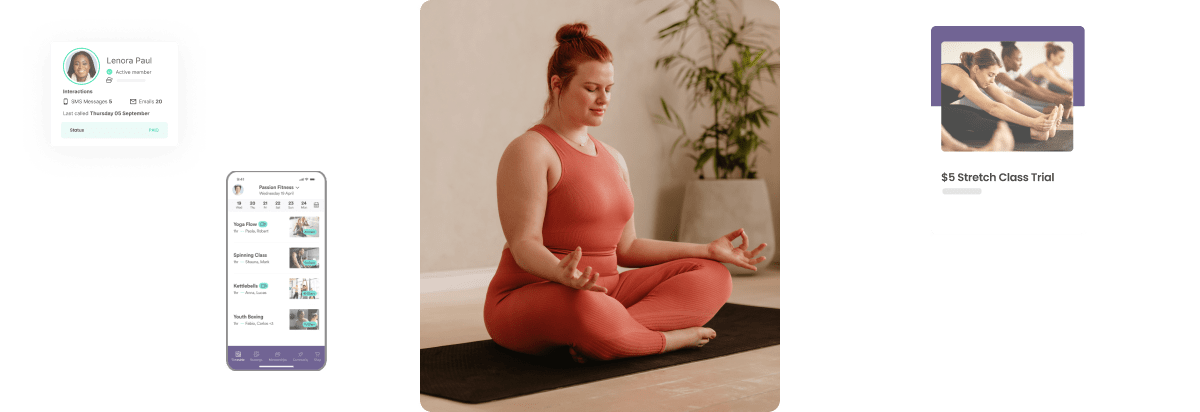With steady annual growth, yoga studio owners are part of a thriving industry. Statistics show that around 37 million Americans practice yoga. This number is a massive increase from 20 million in 2012. A staggering 75% of Americans agree that yoga is beneficial for you, and there are thought to be a total of 300 million yoga practitioners worldwide.
Naturally, as more and more people begin to practice yoga, more and more studios will open. But the critical question is: How many of these studios remain open? And of those studios that are a success, what are the fundamental elements that go into opening and maintaining a successful space?
In this article, we will tackle these issues by looking at five key areas yoga studio owners need to focus on.
Standing out in a Crowded Market
How saturated is the yoga market around you? Remember, with yoga; your competition is not limited to other yoga studios. You can find yoga classes at certain boutique fitness studios, gyms, even martial arts centers will host the occasional class. In some areas, it can be tough to stand out against your competitors. The first place you do this is with your branding.
A strong brand equates to a strong image, an understanding of who you are, and what you offer. Without brand identity, it can be hard to retain customers or even bring them in. There is a selection of key branding mistakes many yoga studio owners make, and you need to consider the following areas when developing your own.
Brand Image
The first step in creating a strong brand involves your brand image. What do you want to represent? What solution are you offering to your clients? Why do people need to come to you? With these in mind, you can then create a logo, a feel, and choose your colors and fonts.
Define Your Target Audience
Your business cannot cater to everyone’s needs; no one can! Think about who you want to attract to your studio and design your classes, pick your teachers, and choose your positioning based on that. This could be yoga for older people, for men, for children, for sports – whichever group you want. The list goes on, find your niche, and stick to it, become known for something, and offer the best available services.
Don’t Be Afraid of Competition
You will not be the only studio, use this to your advantage and stand out from your competition. Look at your competition and see what it is you don’t like about how they are doing things. How will you provide your customers with what you believe to be the perfect mix? Use this as part of your brand messaging.
Be Consistent
When you’ve established what you will offer and chosen your target audience – you need to stand by it. There will always be ways you can evolve, but don’t stray too far away from the purpose that you began with! In the latest episode of The Fitness Founders podcast, Christopher Yax, co-founder of Hot House Yoga, tells us that consistency has been the key to the brand’s success. “I would say if you said what’s the one thing that has been the real secret sauce to your success is consistency. It is consistency; we’re in a service industry, so it’s the experience that people are getting in the yoga room.” During the episode, John and Christopher share some great insights from their 15 years of experience in the industry. It’s worth a listen for all yoga studio owners
Attracting New Members
Converting prospects into customers is challenging for any business, particularly those in a saturated market.
It’s absolutely vital to research your target market and design your classes based on this. Are you offering classes or even describing your classes in a way that will cut out large sections of your desired target market? If your offerings don’t appeal to your audience, they will go elsewhere. Below are some ideas for attracting new members.
Offer Value for New Members
This can come in many forms, but as we’ve discussed recently, the free gym trial isn’t effective in the long run. Get creative with enticing members. During our Hot House Yoga Podcast, John notes; “everyone is literally putting themselves out of business by not charging what they’re worth, and not understanding that money follows the value. If we can present more value for people, we can actually charge more.”
Encourage Your Members to Bring a Friend
Expand your clientele and build your student’s commitment. People have confidence in people they know, and individuals referred to by other clients have a higher retention rate of 37 percent. Potential members are four times more likely to buy when a friend refers them, so it is an important step to encourage references to your studio. Offer loyalty and referral programs and keep new prospects coming through the door.
Get Social
Social media is your best friend when it comes to standing out from competitors and building a yogi community. Start by posting regularly (3-5 times a week) about upcoming classes or events to encourage participation, show off your teachers, and offer healthy tips.
Engage with your clients and always ask for feedback. Facebook and Instagram can be beneficial as they can extend your reach into neighboring communities. Follow your clients on Instagram, as well as any potential or strategic partners. As your budget and popularity increase, brush up on paid marketing on different social media platforms to help reach a broader audience.
Member Retention
Once you have your members in the door and onto their mats, you need to figure out how to keep them coming back. Get creative with some of the following ideas to improve your retention strategy.
The Customer
Engagement Playbook
for Your Fitness
Business
Discover more - Host some motivational challenges and reward people who complete these challenges. Many studios host 30-day challenges, encouraging students to make the most out of the studio and to try out multiple classes.
- Host special events and workshops – it goes back to providing a valuable experience for your customers.
- Keep classes fresh and exciting, provide educational opportunities. What attracted you to your yoga teacher? Provide that motivation and inspiration to your studio.
- Ask for feedback! This is so important! To maintain your client base, you must understand whether or not their desires are being fulfilled.
- Support a good cause and give back to your local community.
Adding Value
Putting a price to your services can be a challenge: you don’t want to overcharge, but simultaneously, you must not undervalue yourself or your staff.
The whole fitness industry has changed massively in recent years. With the increase in boutique studios and yoga shalas, customers are now willing to pay premium prices for premium products. The goal is no longer to have large numbers of people paying minimal costs, who don’t truly value what they are receiving. These people have no reason to stay loyal to one studio. Instead, the goal has shifted towards a ‘quality over quantity’ mindset.
A student who has enrolled themselves in a cheap class will not value it the way they would a more costly purchase. Cheap trials encourage students to jump around from studio to studio without making any commitment. A period of evaluation is, of course, necessary before selecting a teacher or a studio. This can be curtailed by offering an intro pack of three to five classes allowing new students to test out your classes.
Of course, if you are offering your classes at a higher fee than surrounding studios, it goes without saying that you must be offering quality classes. Customers must be aware that there is a wide variety of quality between yoga classes, and this is the difference between progression and real progression on both a physical and spiritual level.
Rember; there is no universal “correct” price.
If you find yourself struggling with this part of the journey, here are some elements to consider that will get you started on pricing your yoga classes.
- Memberships – membership packages provide the most valuable option for your loyal customers. With memberships, you can also consider throwing in discounts on retail, workshops, or other little perks to sweeten the deal.
- Multi-Class Passes – for those who cannot quite commit to membership but plan on coming reasonably regularly.
- Single-Sessions – value these at what you believe they are worth. You want your drop-in to be affordable enough that a new student doesn’t hesitate about trying your classes for the first time. But you also want it to be costly enough that a regular client sees the appeal in buying a multi-class pack or a membership.
- Intro Pack – as mentioned above, a taster pack of 3-5 classes.
Again, valuing yourself correctly is something John talks about during the latest episode of the Fitness Founders podcast: “you charge more because there’s tons of value with it. You’re actually making a difference. You’re taking an amount of pain, you’re transforming their lives, and you’re charging whatever your demographic can handle”.
Additional Revenue
Yoga spending is at an all-time high. How can you make the most out of this?
It is not only yoga practice that is at an all-time high. People are now more willing to spend money on their Lululemons than their jeans. The American market alone spends $16 billion a year on yoga.
Selling retail items – be it yoga clothing, mats, jewelry, blocks, etc. – can be a fantastic way of bringing in extra revenue. And, you don’t need a big space to do this; all it takes is a rack in your lobby or some shelf space. Adding retail will increase revenue at your studio; it will benefit your students and build further value for your community.
Selling retail items offers your students a considerable convenience and gives them a reason to spend more time in your studio. This is also a fantastic way to make your mark and to stand out in a crowded market. Studio owners must continuously assess and reassess how to add value to their customers’ experience. Supplying both essential and non-essential yoga goods boosts the value of your studio for your students. Better yet, if you make malas or essential oils, don’t sell them on Etsy, sell them in your studio!
There are many opportunities to extend your all-round offering within your yoga studio in addition to retail:
- Work with a local nutritionist and offer deals on meal plans or perhaps an initial consultation. This is also a fantastic way to cross-promote)
- Create exclusive mini-courses or workshops – these can focus on a particular posture that clients have all expressed difficulty with, or perhaps an introduction to meditation. Yoga has so much to offer, share your passions with your customers, and they will keep coming back.
- Take the opportunity to speak to your clients, find out what they are missing if they would like to set some goals, and find out how you can help them to achieve these goals.
Creating Convenience
From signing up as a new member, to booking classes and making payments, the customer experience should always be simple. It’s up to you to deliver this straightforward process, and managing the experience should be as simple for you as it is for your customers.
Recent figures show the average American picks up their phone 52 times a day. Whether it’s checking emails, scrolling through Instagram, or watching ‘funniest dog videos’ on YouTube – we live on our phones. Considering this, a great way to stay connected with your customers is with a branded app. An app brings efficiency and ease to the customer experience; creating a profile, booking classes, and making payments are all made in one place.
Using an app doesn’t just make your customers’ lives easier; it turns setting, monitoring, and achieving business goals into a streamlined, manageable process for you. With full integration, you have easy access to customer data that lets you stay connected with clients and provide an efficient and convenient service.
Management software that gives this integration across customer information, bookings, POS, and direct sales is a worthwhile investment. With performance analytics, reports, and first-party customer data; you can personalize your service and take it to the next level.
In Summary
Owning and supervising a yoga studio is by no means an easy feat. Clearly defined goals are a great tool in having a smoother path to success. We have examined a few challenges, but there are, of course, many more; for example, marketing, social media, teachers, and communication, to name a few. It can feel daunting and overwhelming but continue to educate yourself, continue to research your field and your clients. This, coupled with proper planning, and some SMART goals, will have, you will be on the path to great success.
The Customer
Engagement Playbook
for Your Fitness
Business
connects with its customers on a deeper level than a
simple business and consumer relationship.












